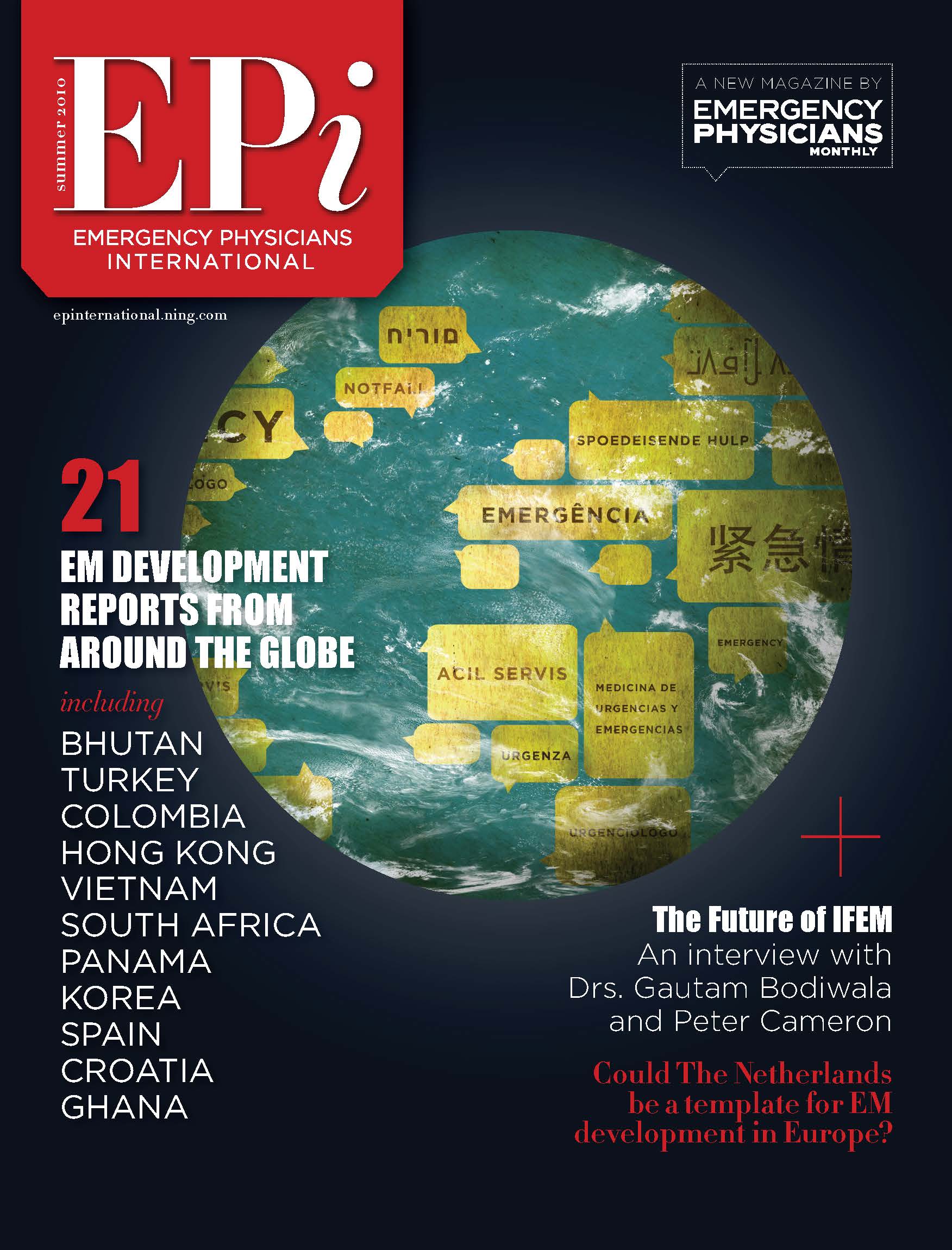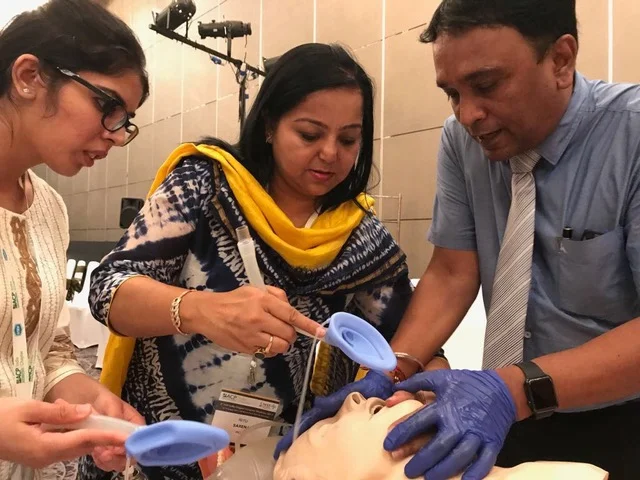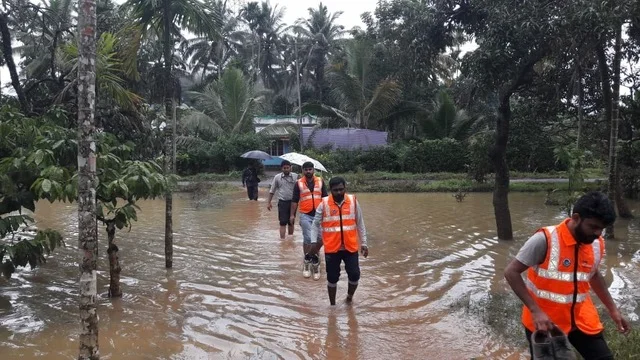Partnership Between India's Max SHBG and GWU Begins to Bear Fruit
By Kevin Davey, MD and Kishalay Datta, MBBS, MD, MRCP, MHA
MAX Superspecialty Hospital Shalimar Bagh (Max SHBG) opened its emergency department (ED) in 2012. At the time it opened, the Max SHBG ED was unique in that it was one of the few hospitals in India with a dedicated emergency department staffed by physicians trained in emergency medicine (EM). The new head of the department, Dr. Kishalay Datta, had been the chair of the ED at another MAX hospital from 2010 to 2012. He came to Max SHBG with the goal of expanding access to emergency care, by creating a center for high quality emergency medicine education and training.
The academic field of emergency medicine is new in India, having only been formally recognized by the Medical Council of India in 2009[1]. Prior to then, most patients presenting to hospitals across India would be triaged to a casualty department where they would be seen by a rotating group of medical officers, none of whom had formal training in emergency medicine. As the healthcare sector in India has grown, and access to insurance has increased, hospitals have begun to recognize the need for improved access to emergency services.
The Need for Emergency Medicine
The need for emergency medicine in India is immense. Injury is the second most common cause of death in India after age 5, second only to ischemic heart disease [2]. It is estimated that in 2016, 415 people died each day in India due to road traffic injuries, a staggering 32% increase in road traffic fatalities since 2007 [3]. Communicable disease still persists and the World Health Organization estimates that India has 2.8 million new cases of tuberculosis and 1.2 million new cases of malaria each year [4]. Despite the need for emergency services, much of the healthcare sector in India has been slow to adapt, particularly regarding the need for quality education and training programs.
As of 2018, officially sanctioned government training programs like the MD or DNB are able to train only 194 emergency physicians per year, presuming all seats are filled, to serve a country of 1.3 billion people [5,6]. Using the United Kingdom and Singapore as comparisons, where there is roughly 1 EM physician for every 10,000 people, India would need to have approximately 132,000 practicing EM physicians to achieve similar proportions [7,8]. As hospitals have struggled to meet their staffing requirements, many have sought alternative means of providing high quality training.
Recognizing the need for improved EM training, in 2014, Max SHBG partnered with George Washington University (GWU) to start the Masters in Emergency Medicine (MEM) program, a 3 year residency training program in Emergency Medicine and acute care. The MEM program has rigorous requirements, including a 36 month modular curriculum, a thesis requirement, monthly exams, and formative assessments throughout the year culminating in a three day written and practical end of program exit exam. Along with the MEM program, in 2014 the Max SHBG ED was also the first ED in India to sponsor a DNB post graduate program in Emergency Medicine, a government sponsored residency training completed at private hospitals. Today the Max SHBG ED is staffed 24 hours a day, 7 days a week by a team of 6 EM trained consultants and 17 residents. The department has portable x- ray, bedside ultrasound and a point of care ABG machine that can give immediate test results for critically ill patients. CT and MRI installed immediately adjacent to the ED are available 24 hours a day to allow for rapid evaluation of patients in need of imaging. With this increased diagnostic and staffing capabilities, the Max SHBG ED has seen a dramatic increase in patient volume. Its annual census has doubled in the in past five years from just over 7,400 patients per year in 2013, to nearly 16,000 in 2018.
Part of the secret to the Max SHBG ED’s success thus far has been a commitment to training and education. As part of their partnership with GWU, local faculty teaching is augmented by visiting international faculty who rotate through the department every month giving dedicated lectures on EM core curriculum and bedside teaching. Along with seeking improved physician training, Max SHBG nurses and paramedics undergo additional training in the National Resuscitation Program (NRP) put on by the Indian Pediatric Association, as well as NIH stroke scale training, and the World Health Organization antibiotic stewardship program. All Max SHBG faculty are trained in BLS, ACLS, ATLS and PALS. Max SHBG faculty and residents have presented their research at national and international conferences including EMCON and the World Trauma Congress. An expert on emergency care and resuscitation, Dr. Datta has been invited to speak at Emergency Medicine conferences both nationally and internationally, most recently giving Trauma Grand Rounds at the ALFRED Trauma Centre in Melbourne, Australia in 2018. Dr. Datta published The Vent Book: A Guid to Mechanical Ventilation in the Emergency Room in 20179, which is sold throughout India, the United States, and the U.K. Physicians at Max SBGH have also spearheaded community outreach efforts, giving free BLS training sessions in local schools and businesses.
As a result of their efforts the Max SHBG ED has been recognized locally and nationally. In 2016 Max SHBG was designated a Center for Excellence by the Society for Emergency Medicine in India (SEMI). In 2018 the Max SHBG ED was recognized for academic excellence by the Delhi Medical Association. That same year they were also recognized for their quality improvement efforts in the 2018 Medical Quality Forum for the Delhi Region. As of 2018 Max
SHBG has graduated 18 MEM and 15 DNB Emergency Medicine residents. Max SHBG graduates have gone on to successful careers in India and around the world. While most graduates stay in India serving their local communities, nine have passed their MRCEM exams and gone on to work in the United Kingdom, a testament to the quality of training at Max SHBG. The Max SHBG ED remains dedicated to their mission to expand access to emergency care in India through evidence based medicine and providing high quality training for the next generation of emergency physicians.
1) Jain M, B Batra, E Clark, T Kole. Development of Post-graduate program in emergency medicine in India: Current status, scope, and career pathways. Medical Education: New Frontiers. 2014;1(3),218-221.
2) WHO India Country Cooperation Strategy. Accessed at http://apps.who.int/iris/bitstream/handle/10665/13689 5/ccsbrief_ind_en.pdf;jsessionid=A307351DCB9210 9402D0D6ACC171B21D?sequence=1 on 10/11/2018.
3) Road Crash Statistics 2016. Analysis of Transport Research Wing, Ministry of Road Transport and Highways Data 2016. Accessed at http://savelifefoundation.org/wp- content/uploads/2017/10/Traffic-Research-Wing- Data2016_Analysis_SLF.pdf on 10/11/2018.
4) WHO India Country Cooperation Strategy. Accessed at http://apps.who.int/iris/bitstream/handle/10665/13689 5/ccsbrief_ind_en.pdf;jsessionid=A307351DCB9210 9402D0D6ACC171B21D?sequence=1 on 10/11/2018.
5) Indicative Seat Matrix – DNB PDCET January 2018 Admission Session. Accessed at https://www.natboard.edu.in/pdoof/pbnotice2018/cns /DNB%20PDCET%20Indicative%20Seat%20Matrix %20Jan%202018%20-%2028.03.2018.pdf?h88233er hx90wsd0q2wk2s2ks2 10/11/2018.
6) National Board of Examinations Counseling and Registration website, available at https://www.cns.natboard.edu.in/CandRv1/seatMatri x/view_seats.php?transid=cFpWb1FqczlRSUh5MTR hN0xETFBKZz09accessed on 10/11/2018.
7) NHS Key Statistics England May 2018 House of Commons Library Briefing Paper Number 7281, 21 May 2018 Accessed at https://researchbriefings.parliament.uk/ResearchBrief ing/Summary/CBP-7281 on 10/11/2018.
8) Pek, Jen Heng, et al. “Emergency Medicine as a Specialty in Asia.” Acute Medicine & Surgery, vol. 3, no. 2, 2015, pp. 65–73., doi:10.1002/ams2.154.
9) DATTA, KISHALAY. VENT BOOK: a Guide to Mechanical Ventilation in Emergency Room. JAYPEE Brothers MEDICAL P, 2017.









